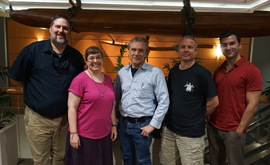Continuing the search for and study of stars in IC417, the Spider Nebula.
2020 abstract:
The Spider Nebula (IC 417) is a star-forming region about 2.3 kpc away, in the direction of the Galactic anti-center. While not in the outer reaches of the Galaxy by any means, IC 417 is still further towards the outer reaches of the Galaxy than most of the well-studied star-forming regions. If star formation there is significantly different from star formation elsewhere (perhaps due to metallicity or stellar density), it might manifest in a different distribution of masses (initial mass function). The first step to understanding whether star formation is different there is to take an inventory of the cluster member stars. We will be working towards a complete list of members of IC 417. This region was studied by a NITARP team in 2015, and we are continuing and enhancing their investigation, adding new data released after their work, most notably Gaia DR2 and PanSTARRS. Between the prior NITARP team and the rest of the literature, there are several hundred known young stellar objects (YSOs) and candidate YSOs. There is a somewhat overlooked portion of IC 417 called the Nebulous Stream (NS) that is most obvious in the mid-IR (3.6, 4.5 μm). Our first goal is to explore the stellar content of the NS and add to the list of candidate YSOs. Our second goal is to apply the new data sources to the prior list of YSOs and assess whether or not we still believe them to be YSOs. We will use optical through far-infrared data, construct spectral energy distributions (SEDs), inspect images where possible to ensure isolated point sources, and create color-color and color-magnitude diagrams to help us identify YSO candidates.
2021 abstract:
The Spider Nebula (IC 417) is a star forming region about 2.3 kpc away, in the direction of the Galactic Anti-center. While not in the outer reaches of the Galaxy by any means, IC417 is still further towards the outer reaches of the Galaxy than most well-studied star forming regions. If star formation here is significantly different from star formation elsewhere (e.g., perhaps due to metallicity or stellar density), it might manifest, say, in a different distribution of masses (initial mass function). In order to investigate this, we need to assemble a list of cluster members.
In 2015, a NITARP team studied this region, finding young stellar object (YSO) candidates from IR excesses. In 2020, our team studied this region, identifying new YSO candidates in a part of the nebula called the Nebulous Stream, and assessing all literature-identified YSOs in the optical and IR. At the end of 2020, we had a list of ~600 YSO candidates. In 2021, we will continue our exploration of this region. We will incorporate ~100 more YSO candidates identified in the literature last year into our work from last year, and wrap up a few loose ends from that work, largely related to color-color and color-magnitude diagrams. The bulk of our work this year will explore the variability properties of these ~700 YSO candidates using optical (ZTF and ASAS-SN) and infrared (NEOWISE) light curves.
Caltech, Pasadena, California
Academy of Information Technology & Engineering, Stamford, Connecticut
JL Mann High School, Academy of Mathematics, Science, and Technology, Greenville, South Carolina
Crescenta Valley High School, La Crescenta, California
James Madison Memorial High School, Madison, Wisconsin Madison College, Madison, Wisconsin MMSD Planetarium, Madison, Wisconsin
We have another astronomy research journal publication! Rebull et al. 2023 combines work from two NITARP teams, this 2015 team and this 2020/2021 team.
